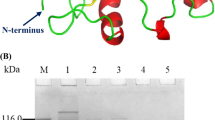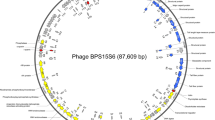Abstract
Clostridium perfringens is one of the major foodborne pathogens in humans and animals. With the prevalence of antibiotic-resistant C. perfringens strains, bacteriophages and their endolysins have received considerable attention as promising alternatives to antibiotics. In this study, C. perfringens phage CPD2 was isolated from retail chicken samples. CPD2 belongs to the Podoviridae family and exhibits remarkable thermostability. While CPD2 has narrow host specificity, its endolysin LysCPD2 showed a broader lytic range, killing not only C. perfringens strains but other Gram-positive bacteria, such as B. cereus and B. subtilis. In addition, due to its exceptional thermal stability, LysCPD2 showed significant antibacterial ability against germinating C. perfringens spores during the heat activation process (75 °C for 20 min). Taken together, these results indicate that both thermostable phage CPD2 and its endolysin LysCPD2 can be used as efficient antimicrobial agents to control C. perfringens during thermal processing of foods.




Similar content being viewed by others
References
Akhtar S, Paredes-Sabja D, Torres JA, Sarker MR. Strategy to inactivate Clostridium perfringens spores in meat products. Food Microbiology. 26: 272-277 (2009)
Alnoman M, Udompijitkul P, Sarker MR. Chitosan inhibits enterotoxigenic Clostridium perfringens type A in growth medium and chicken meat. Food Microbiology. 64: 15-22 (2017)
Andersen KG, Hansen TB, Knøchel S. Growth of Heat-Treated Enterotoxin-Positive Clostridium perfringens and the Implications for Safe Cooling Rates. Journal of Food Protection. 67: 83-89 (2004)
Aziz RK, Bartels D, Best A, DeJongh M, Disz T, Edwards RA, Formsma K, Gerdes S, Glass EM, Kubal M, Meyer F, Olsen GJ, Olson R, Osterman AL, Overbeek RA, McNeil LK, Paarmann D, Paczian T, Parrello B, Pusch GD, Reich C, Stevens R, Vassieva O, Vonstein V, Wilke A, Zagnitko O. The RAST Server: Rapid annotations using subsystems technology. BMC Genomics. 9: 1-15 (2008)
Chang Y, Ryu S. Characterization of a novel cell wall binding domain-containing Staphylococcus aureus endolysin LysSA97. Applied Microbiology and Biotechnology. 101: 147-158 (2017)
De Jong AEI, Beumer RR, Rombouts FM. Optimizing sporulation of Clostridium perfringens. Journal of Food Protection. 65: 1457-1462 (2002)
Fancher CA, Thames HT, Colvin MG, Zhang L, Nuthalapati N, Kiess A, Dinh TTN, Sukumaran AT. Research Note: Prevalence and molecular characteristics of Clostridium perfringens in “no antibiotics ever” broiler farms. Poultry Science. 100: 101414 (2021)
Fathima B, Archer AC. Bacteriophage therapy: recent developments and applications of a renaissant weapon. Research in Microbiology. 172: 103863 (2021)
Fauquet CM, Fargette D. International Committee on Taxonomy of Viruses and the 3,142 unassigned species. Virology Journal. 2: 1-10 (2005)
Fischetti VA. Bacteriophage lysins as effective antibacterials. Current Opinion in Microbiology. 11: 393-400 (2008)
Fischetti VA. Bacteriophage endolysins: A novel anti-infective to control Gram-positive pathogens. International Journal of Medical Microbiology. 300: 357-362 (2010)
Ha E, Son B, Ryu S. Clostridium perfringens virulent bacteriophage CPS2 and its thermostable endolysin lysCPS2. Viruses. 10: 1-10 (2018)
Henriques AO, Moran CP. Structure and assembly of the bacterial endospore coat. Methods. 20: 95-110 (2000)
Kazanavičiūtė V, Misiūnas A, Gleba Y, Giritch A, Ražanskienė A. Plant-expressed bacteriophage lysins control pathogenic strains of Clostridium perfringens. Scientific Reports. 8: 10589 (2018)
la Mora ZV De, Macías-Rodríguez ME, Arratia-Quijada J, Gonzalez-Torres YS, Nuño K, Villarruel-López A. Clostridium perfringens as foodborne pathogen in broiler production: Pathophysiology and potential strategies for controlling necrotic enteritis. Animals. 10: 1-28 (2020)
Lavigne R, Briers Y, Hertveldt K, Robben J, Volckaert G. Identification and characterization of a highly thermostable bacteriophage lysozyme. Cellular and Molecular Life Sciences. 61: 2753-2759 (2004)
Lee C, Kim J, Son B, Ryu S. Development of advanced chimeric endolysin to control multidrug-resistant Staphylococcus aureus through domain shuffling. ACS Infectious Diseases. 7: 2081-2092 (2021)
Lee C, Kim H, Ryu S. Bacteriophage and endolysin engineering for biocontrol of food pathogens/pathogens in the food: recent advances and future trends. Critical Reviews in Food Science and Nutrition. 1-20 (2022)
Lewis R, Clooney AG, Stockdale SR, Buttimer C, Draper LA, Ross RP, Hill C. Isolation of a novel jumbo bacteriophage effective against Klebsiella aerogenes. Frontiers in Medicine. 7: 67 (2020)
Loessner MJ. Bacteriophage endolysins - Current state of research and applications. Current Opinion in Microbiology. 8: 480-487 (2005)
Mehdizadeh Gohari I, A. Navarro M, Li J, Shrestha A, Uzal F, A. McClane B. Pathogenicity and virulence of Clostridium perfringens. Virulence. 12: 723-753 (2021)
Park H, Kim J, Kim H, Cho E, Park H, Jeon B, Ryu S. Characterization of the lytic phage MSP1 for the inhibition of multidrug-resistant Salmonella enterica serovars Thompson and its biofilm. International Journal of Food Microbiology. 110010 (2022)
Quevillon E, Silventoinen V, Pillai S, Harte N, Mulder N, Apweiler R, Lopez R. InterProScan: Protein domains identifier. Nucleic Acids Research. 33: 116-120 (2005)
Schleifer KH, Kandler O. Peptidoglycan types of bacterial cell walls and their taxonomic implications. Bacteriological Reviews. 36: 407-477 (1972)
Schmelcher M, Loessner MJ. Bacteriophage endolysins: applications for food safety. Current Opinion in Biotechnology. 37: 76-87 (2016)
Sharma U, Vipra, A, Channabasappa S. Phage-derived lysins as potential agents for eradicating biofilms and persisters. Drug Discovery Today. 23: 848-856 (2018)
Smith CJ, Olszewska MA, Diez-Gonzalez F. Selection and application of natural antimicrobials to control Clostridium perfringens in sous-vide chicken breasts inhibition of C. perfringens in sous-vide chicken. International Journal of Food Microbiology. 347: 109193 (2021)
Strain D, Li J, Chen J, Vidal JE, Mcclane BA. The Agr-like quorum-sensing system regulates sporulation and production of enterotoxin and beta2 toxin by Clostridium perfringens type A non-food-borne human gastrointestinal disease strain F5603. Infection and Immunity. 79: 2451-2459 (2011)
Swift SM, Reid KP, Donovan DM, Ramsay TG. Thermophile lytic enzyme fusion proteins that target Clostridium perfringens. Antibiotics. 8: 214 (2019)
Szweda P, Schielmann M, Kotlowski R, Gorczyca G, Zalewska M, Milewski S. Peptidoglycan hydrolases-potential weapons against Staphylococcus aureus. Applied Microbiology and Biotechnology. 96: 1157-1174 (2012)
Thippareddi H, Juneja VK, Phebus RK, Marsden JL, Kastner CL. Control of Clostridium perfringens germination and outgrowth by buffered sodium citrate during chilling of roast beef and injected pork. Journal of Food Protection. 66: 376-381 (2003)
Volozhantsev NV, Oakley BB, Morales CA, Verevkin VV, Bannov VA, Krasilnikova VM, Popova AV, Zhilenkov EL, Garrish JK, Schegg KM, Woolsey R, Quilici DR, Line JE, Hiett KL, Siragusa GR, Svetoch EA, Seal BS. Molecular characterization of Podoviral bacteriophages virulent for Clostridium perfringens and their comparison with members of the Picovirinae. PLoS ONE. 7 (2012)
Vollmer W. Bacterial outer membrane evolution via sporulation?. Nature Chemical Biology. 8: 14-18 (2012)
Walmagh M, Boczkowska B. Characterization of five novel endolysins from Gram-negative infecting bacteriophages. Applied microbiology and biotechnology. 97: 4369-4375 (2013)
Warda AK, den Besten HMW, Sha N, Abee T, Nierop Groot MN. Influence of food matrix on outgrowth heterogeneity of heat damaged Bacillus cereus spores. International Journal of Food Microbiology. 201: 27-34 (2015)
Wells-Bennik MHJ, Eijlander RT, Den Besten HMW, Berendsen EM, Warda AK, Krawczyk AO, Nierop Groot MN, Xiao Y, Zwietering MH, Kuipers OP, Abee T. Bacterial spores in food: Survival, emergence, and outgrowth. Annual Review of Food Science and Technology. 7: 457-482 (2016)
Zeugin JA, Hartley JL. Ethanol precipitation of DNA. Focus. 7: 1-2 (1985)
Acknowledgements
This work was supported by a grant from the National Research Foundation of Korea (NRF) funded by the Korean government (2020R1A2B5B03094303 to S. Ryu and 2020R1C1C1008127 to M. Kong.
Author information
Authors and Affiliations
Corresponding author
Ethics declarations
Conflict of interest
The authors have no conflict of interest to declare.
Additional information
Publisher's Note
Springer Nature remains neutral with regard to jurisdictional claims in published maps and institutional affiliations.
Rights and permissions
Springer Nature or its licensor (e.g. a society or other partner) holds exclusive rights to this article under a publishing agreement with the author(s) or other rightsholder(s); author self-archiving of the accepted manuscript version of this article is solely governed by the terms of such publishing agreement and applicable law.
About this article
Cite this article
Shin, D., Ha, E., Kong, M. et al. Characterization of thermostable bacteriophage CPD2 and its endolysin LysCPD2 as biocontrol agents against Clostridium perfringens. Food Sci Biotechnol 32, 2069–2077 (2023). https://doi.org/10.1007/s10068-023-01314-0
Received:
Revised:
Accepted:
Published:
Issue Date:
DOI: https://doi.org/10.1007/s10068-023-01314-0




